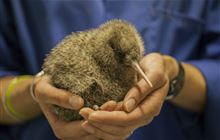Wildlife Health online course
Introduction
This free online course demonstrates the application of ‘best practice’ for a range of avian veterinary techniques in use with New Zealand birds.What's the course about?
There are eight modules explaning commonly applied procedures which will help with your day-to-day wildlife health work.
The modules will provide an excellent grounding in what is required and what equipment is needed. However, further practical field based training is requisite for you to be qualified to use these techniques on a bird.
Each module takes between 40–70 minutes to complete.
- Module 1 - Introduction to wildlife health
This module introduces the principles of wildlife health, giving examples of why wildlife health techniques are important. Basic bird handling and stress management are also discussed. It contains important information which makes it a pre-requisite to Modules 2-8. - Module 2 - Avian blood sampling
In this module you will learn how to take a blood sample from a range of avian species. You will also be shown how to prepare a blood smear and how to correctly handle and process blood samples. - Module 3 - Avian crop tubing
How to safely give fluids, liquid food or medications orally into the crop or oesophagus in a range of bird species. - Module 4 - Avian physical examination
In this module you will learn how to examine a bird from tip (beak) to toe for signs of ill health. - Module 5 - Avian swab techniques
In this module you will learn how to take a range of microbiological swabs from birds, and how to process the samples to send to the laboratory. - Module 6 - Avian necropsy technique
In this module you will learn how to perform a thorough necropsy (post-mortem examination) on a deceased bird. You will also learn how to collect samples for culture and how to take samples for formalin fixing. - Module 7 - Avian bandaging techniques
In this module you will learn how to safely apply a supportive bandage for a broken or injured wing, leg, or foot of a bird. - Module 8 - Avian subcutaneous fluids technique
In this module you will learn how to inject fluids under the skin of a bird. This includes selecting a site, preparing the site aseptically and the process of injecting the fluids safely.
Who is it for?
The modules are designed for people who use veterinary techniques on wildlife. This includes Department of Conservation staff, volunteers, wildlife rehabilitators, community groups, researchers and contractors.
Note: Handling fully protected and partially protected wildlife, as defined in the Wildlife Act 1953, requires a permit from the Department of Conservation.
Start the course
Need help? Contact capabilitydevelopment@doc.govt.nz.

